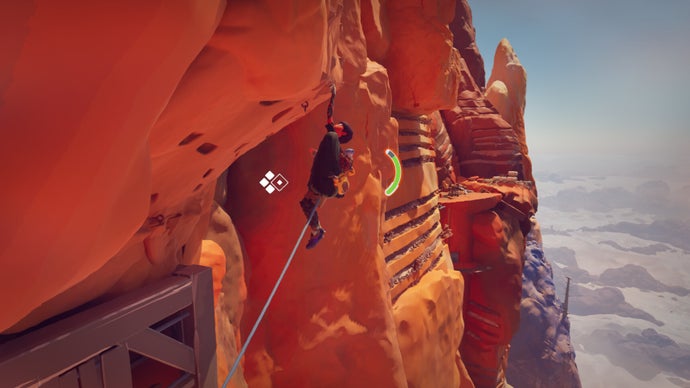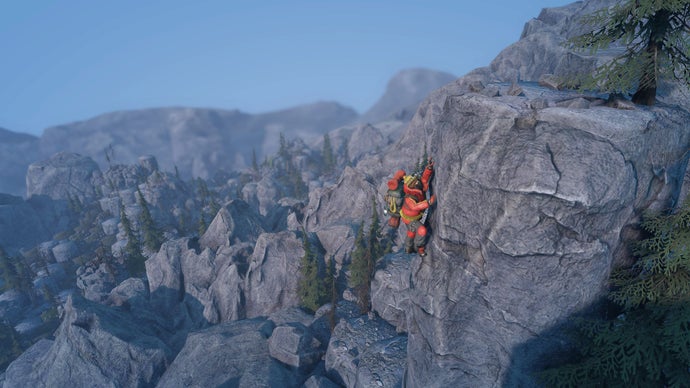It was Digital Foundry’s John Linneman who first made me see the truth. The truth, in this case, being that Crackdown, the deliriously great open-world blaster, is not a platform game so much as it’s a climbing game. Crackdown casts you as a supercop in a city in which you can race up skyscrapers as easily as if you’re tooling down the street in a sportscar. Crackdown is all about the window-ledge grip, followed by the boost, followed by the grip and so on until you hit the troposphere. When you scan the side of a building in Crackdown’s Pacific City, you’re not really looking for platforms, but handholds.
Funny it should take me so long to realise this. I’ve always been a fan of climbing – not doing it, although I have dabbled, skill-lessly, in my youth, but following it, reading about it, dreaming about it. I have friends who are climbers and I am always full of questions. I’ve read the complete works of people like Alex Honnold and Chris Bonington. Bonington was my mum’s childhood – and adulthood – hero, incidentally. I’m named after him, and on my desk at home I have a postcard of him as a young man, wearing a dark, surprisingly formal jacket, up somewhere high, and with a thick cord of ropes over his shoulder. It’s a picture of pure adventure. What a disappointment to him I must be.
At that desk, though, I do quite a bit of climbing. I climbed through Crackdown, without realising it, and recently I climbed through Jusant. With the release of a new climbing game this week, I’ve been thinking about how it all fits together. Climbing feels, of all activities, uniquely physical to me, because it’s about rock and about hands and about clasping. It’s about connections, points of contact, cleaving to a part of the natural world and holding on tight. How do games do that?
Jusant, which is still relatively fresh in my mind, is a science fiction, post-apocalyptic affair, filled with strange creatures and magical plants and day-glo mushrooms and ancient, inscrutable technology. The climbing, though, it plays straight – astonishingly straight really. Jusant gives you a rope and a bunch of pitons, and its stamina meter encourages you to break its vertical world into sections, like real climbers do. It’s a game I tackled in thought-provoking, sometimes exhausting chunks, always aware of that rope trailing behind me. I jumped and did a bit of that arcing side-run thing, I worried endlessly about exposure, and at times, when I saw something fascinating just out of reach, I did what you’re meant to never do in climbing and I over-extended myself. Idiot.
Jusant gave me what I wanted from a climbing game, and I’m not just referring to the views, or the sense of travelling somewhere rarified and out of reach to most of us. It was a perfect combination of things to think about – how, which way, where to start – and physical stuff, most of it channeled through my favourite jump in all of recent video games. You lean away, still your breathing, aim as best you can, and then fling yourself. I sometimes find myself with my eyes squeezed shut in these moments. You’re using the stick, but it feels like I’m flinging my whole body.

Surmount, which is the new climbing game I mentioned a few paragraphs up, takes similar ideas and handles them in a very different way. You have the left-right trigger grips which I think I first encountered in Grow Home – oh, gosh, there is a game about climbing, but I’ve talked about it too much in the past – and yet the arcadey chaos is dialled up. You can grab onto the rock and then literally turn yourself head over heels to move from one grip to the next. Meanwhile, the signature move here is a kind of spin, in which you build momentum before letting go. Hopefully you fly across the map in the direction you were hoping to go in. Often, I find myself crashing to earth instead.
This is the thing: Surmount presents itself as a goofy sort of game, but it’s actually incredibly challenging, and a lot of that challenge comes down to the fact that the mountain you’re climbing is magical and is always re-arranging itself. I’m making slow progress, but I’m enjoying the physics, which seems to capture a little of the rubber-band physicality of something like Climbing Flail, and what I really love is the camera. You’re far back from the action here, so your climber is small and the mountain is often just a sheer wall that fills the screen. Surmount is a cartoon confection, but it has that daunting sense of scale that every climbing game should have. It makes you feel like you’re venturing into a landscape you don’t belong in, and that’s thrilling to me.
Insurmountable is very different, even if it, too, wants to make you feel like you’re pushing things a bit too far with every step. Insurmountable came out a few years back and I’ve been circling it since then without really engaging. Now I have, and it’s odd and clever and quietly magical.
This is climbing as a sort of tactics game with a bit of narrative roguelike thrown in. You move over a mountain made of hex tiles, and you encounter little story sections where you have to decide whether to go into a cave, say, and whether to bother the person you find sleeping inside it. Fundamentally, though, it’s a game of resource management as you pit yourself against the mountain and try to measure out your ascent safely. Warmth, energy, oxygen and sanity can’t be relied upon. You have to do a bit of inventory Tetris when you pick up new supplies. You can only use a tent three times for sleeping before it’s worn out.
There’s a lot of things about Insurmountable that are fiddly and probably annoying, but a handful of them really add to the atmosphere for me. The game has a wonky camera that means your mountaineer frequently passes out of view when you send them to a distant hex. Irritating, I guess, but I also felt very vulnerable in such moments. I was the mountaineer and I also wasn’t: I was the person who had sent them on their way, and now I couldn’t see them! I feel the same vulnerability when night falls suddenly, or when a snowstorm blows up around me like I’ve stepped on a strange meteorological landmine.

Insurmountable’s stagey, with its meters for warmth and sanity, and with its little FTL vignettes, but for all its gameiness, it captures the sense of a lonely exhausted slog that I read about again and again in a Bonington book. There’s always a moment with Bongington where he’s been up there too long and it’s too cold and too annoying and you can tell he’s questioning why he puts himself through this. Even the hexagonal mountain in Insurmountable, once you look past the board game/giant’s causeway stuff, starts to feel like it’s part of the point the game is making. Maybe this is a glimpse of the privileged way an expert can read a landscape, with clear patches, glowing paths, and obvious signs that there’s something of interest up ahead.
Where to end? Let’s move from Insurmountable to Unsurmountable, and from a tactics PC game to a tactics card game. Unsurmountable is designed by Scott Almes as a solo game, and it comes as a stack of cards that fits in a snug little plastic wallet. This game is a delight. I love mountains, and I’ve also been after a physical game that I can play on my own for a while – a game I can learn the ins and outs of and cast as much as play, like it’s a sort of divination tool. Unsurmountable is like all the other mountain games – get from the bottom to the top. But you do this by placing cards, either by using the paths on them to piece together a route, or by using the effects they each bestow when a route isn’t clear. It’s a choice. Do you want the card with two trails leading upwards, or do you want its power to shuffle all your remaining cards?
You climb the mountain by building a sort of triangle of cards – the mountain gets narrower until it tops out and you’re done. In a way, the path is the only thing that’s real – if there’s no path, there’s no mountain. I love that.
I have yet to finish this game successfully, but I’ll keep plugging away, learning the rules until they’re instinctual, then learning the nuances, getting favourite cards, and then getting new favourites. I love the fact that the mountain is always different, but the kind of challenge is always the same. And I love the fact that for someone like me, who’s read about climbing much more than they’ve actually done it, the whole thing is there to be imagined into life. Onwards! See you at base camp.
A copy of Surmount was provided by Popagenda.
